Avoid getting scammed by fake "UniCredit Bank" emails
Phishing/ScamAlso Known As: UniCredit Bank spam
Get free scan and check if your device is infected.
Remove it nowTo use full-featured product, you have to purchase a license for Combo Cleaner. Seven days free trial available. Combo Cleaner is owned and operated by RCS LT, the parent company of PCRisk.com.
What is "UniCredit Bank Email Virus"?
Cyber criminals use the "UniCredit Bank Email Virus" scam to trick recipients of bogus emails into infecting their computers with a malicious program called FormBook. They proliferate an email that contains a malicious attachment that, once opened, causes the computer infection.
This email is presented as a notification from UniCredit Bank, however, this is simply a scam and it should not be trusted or taken seriously. We strongly recommend that you ignore it.
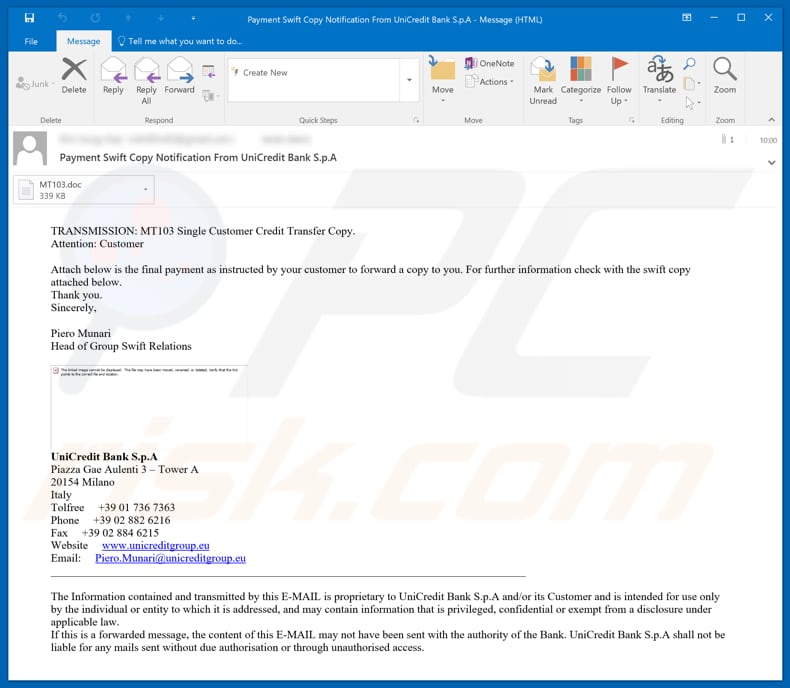
"UniCredit Bank" email virus overview
UniCredit is a financial services company, a legitimate Italian banking company, which has nothing to do with this email scam. Cyber criminals (scammers) often use well-known company names and present the email as a notification regarding confirmation of payment by SWIFT Copy.
Recipients are encouraged to check for further information by checking the included attachment. In the screenshot above, the attachment is a "MT103.doc" file, however, other examples can be found below.
Cyber criminals who proliferate the "UniCredit Bank Email Virus" scam attach documents with different names and content, however, all attachments proliferate the same FormBook computer infection. FormBook is high-risk computer infection, a malicious program that is distributed mostly through spam emails such as this one.
The FormBook tool is used by many cyber criminals to monitor computer activity and record data. It is capable of recording keystrokes, taking screenshots, and collecting other data such as saved passwords, logins, visited websites, and so on. Some of the data might contain personal details such as banking information.
Cyber criminals use these tools to target data/information that can be used to generate revenue. Therefore, having these programs installed can lead to various problems, including financial loss and other computer infections such as ransomware.
Therefore, we strongly recommended that you ignore emails such as "UniCredit Bank Email Virus". More importantly, do not to open attachments presented within these emails.
| Name | UniCredit Bank spam |
| Threat Type | Trojan, Password stealing virus, Banking malware, Spyware |
| Symptoms | Trojans are designed to stealthily infiltrate victim's computer and remain silent thus no particular symptoms are clearly visible on an infected machine. |
| Distribution methods | Infected email attachments, malicious online advertisements, social engineering, software cracks. |
| Damage | Stolen banking information, passwords, identity theft, victim's computer added to a botnet. |
| Malware Removal (Windows) |
To eliminate possible malware infections, scan your computer with legitimate antivirus software. Our security researchers recommend using Combo Cleaner. Download Combo CleanerTo use full-featured product, you have to purchase a license for Combo Cleaner. 7 days free trial available. Combo Cleaner is owned and operated by RCS LT, the parent company of PCRisk.com. |
Malspam campaign examples
This is just one of many email scams that proliferate high-risk computer infections. Other similar scams include "Love Letter", "Y.E DESIGN", "UNILEVER", and many more. Examples of computer infections spread using these spam campaigns are Adwind, LokiBot, TrickBot, and Emotet.
The main aim of scammers behind these emails is to infect as many computers as possible and to generate revenue by stealing personal, sensitive information.
How did "UniCredit Bank Email Virus" infect my computer?
An example of a possible attachment are .doc files (Microsoft Office documents). To infect computers, these attachments must first be opened.
Note that Microsoft Office has implemented "Protected View" mode, which can protect systems from infiltration of viruses. When a document is opened, rogue attachments asks permission to enable editing or macro commands.
If they are enabled, the rogue document will have permission to download and install a malicious program - in this case, FormBook.
How to avoid installation of malware?
To avoid computer infections, deal with received emails carefully, especially if they are received from unknown, suspicious/irrelevant addresses or contain attachments (or website links). These emails should be studied before opening any attachments.
Bear in mind that cyber criminals often use well-known company names to present these emails as legitimate, or they make offers to win prizes. Download, install and update software using official tools/sources.
Many third party tools (such as downloaders, peer-to-peer networks, and so on) should not be trusted and are used by cyber criminals to proliferate computer infections. Avoid using software cracking tools, since this is illegal and risks computer infections.
Cyber criminals often use these tools to install malicious programs rather than activating licensed software or operating systems. Have reputable anti-virus or anti-spyware software installed and running - these tools can prevent malicious programs from infecting computers by detecting and removing them.
If you have already opened a "UniCredit Bank Email Virus" attachment, we recommend running a scan with Combo Cleaner Antivirus for Windows to automatically eliminate infiltrated malware.
Text presented in the "UniCredit Bank Email Virus" email message:
Subject: Payment Swift Copy Notification From UniCredit Bank S.p.A
TRANSMISSION: MT103 Single Customer Credit Transfer Copy.
Attention: Customer
Attach below is the final payment as instructed by your customer to forward a copy to you. For further information check with the swift copy attached below.
Thank you.
Sincerely,
Piero Munari
Head of Group Swift Relations
UniCredit Bank S.p.A
Piazza Gae Aulenti 3 – Tower A
20154 Milano
Italy
Tolfree +39 01 736 7363
Phone +39 02 882 6216
Fax +39 02 884 6215
Website www.unicreditgroup.eu
Email: Piero.Munari@unicreditgroup.eu
____________________________________________________________________________________
The Information contained and transmitted by this E-MAIL is proprietary to UniCredit Bank S.p.A and/or its Customer and is intended for use only by the individual or entity to which it is addressed, and may contain information that is privileged, confidential or exempt from a disclosure under applicable law.
If this is a forwarded message, the content of this E-MAIL may not have been sent with the authority of the Bank. UniCredit Bank S.p.A shall not be liable for any mails sent without due authorisation or through unauthorised access.
Few examples of malicious attachments distributed via "UniCredit Bank Email Virus" spam campaign:
Appearance of a UniCredit Bank-themed spam email (written in Italian language) used for phishing purposes:
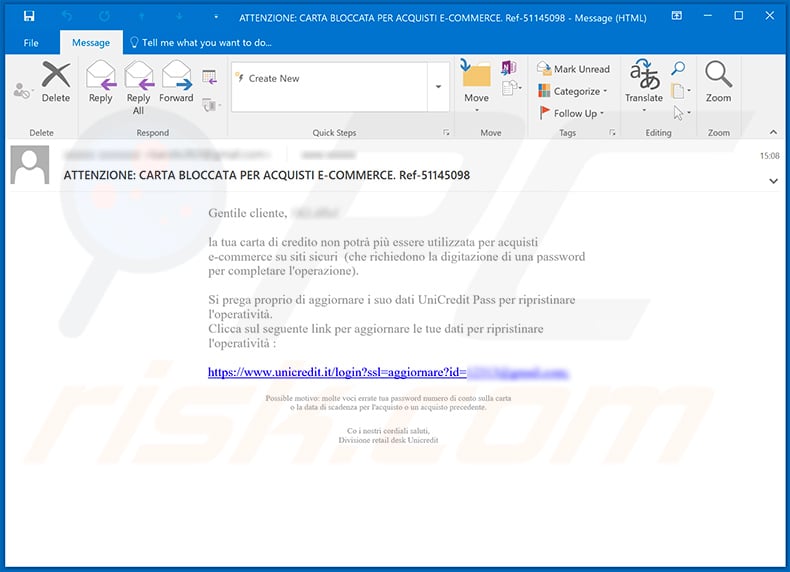
Text presented within:
Subject: ATTENZIONE: CARTA BLOCCATA PER ACQUISTI E-COMMERCE. Ref-51145098
Gentile cliente, -
la tua carta di credito non potrà più essere utilizzata per acquisti
e-commerce su siti sicuri (che richiedono la digitazione di una password
per completare l'operazione).
Si prega proprio di aggiornare i suo dati UniCredit Pass per ripristinare
l'operatività.
Clicca sul seguente link per aggiornare le tue dati per ripristinare
l'operatività :
hxxps://www.unicredit.it/login?ssl=aggiornare?id=*****;
Possible motivo: molte voci errate tua password numero di conto sulla carta
o la data di scadenza per l'acquisto o un acquisto precedente.
Co i nostri cordiali saluti,
Divisione retail desk Unicredit
Screenshot of a fake UniCredit website (unicreditprivati-it[.]com) promoted via this email:
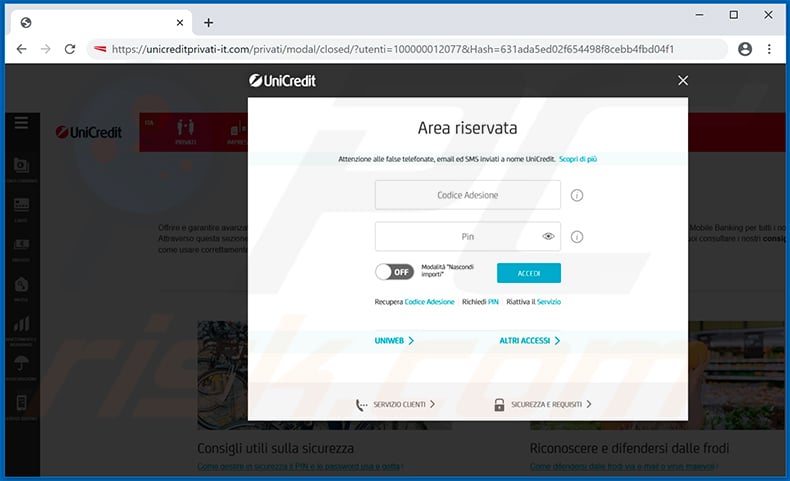
Another example of UniCredit Bank-themed spam email spreading Agent Tesla malware:
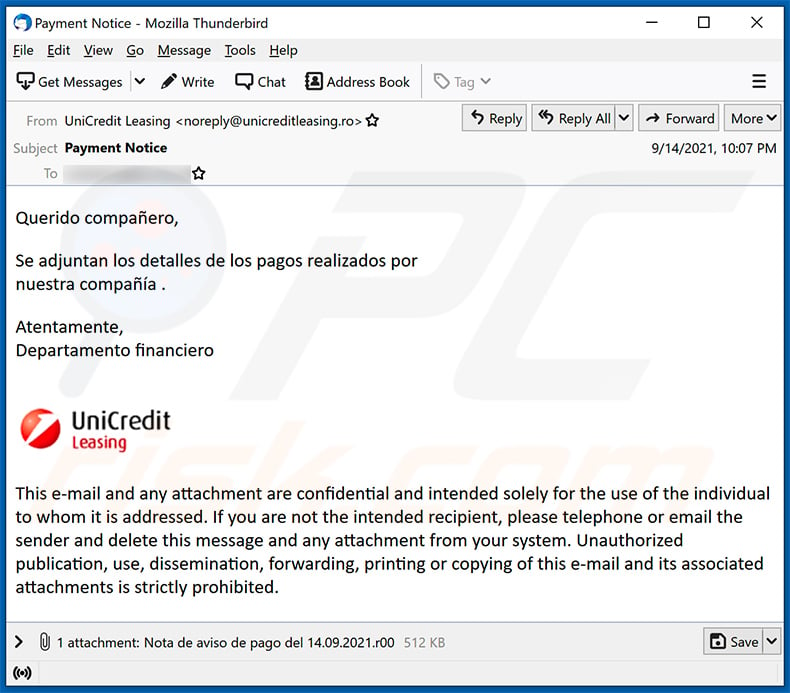
Text presented within:
Subject: Payment Notice
Querido compañero,
Se adjuntan los detalles de los pagos realizados por
nuestra compañía .Atentamente,
Departamento financieroUniCredit Leasing
This e-mail and any attachment are confidential and intended solely for the use of the individual to whom it is addressed. If you are not the intended recipient, please telephone or email the sender and delete this message and any attachment from your system. Unauthorized publication, use, dissemination, forwarding, printing or copying of this e-mail and its associated attachments is strictly prohibited.
Instant automatic malware removal:
Manual threat removal might be a lengthy and complicated process that requires advanced IT skills. Combo Cleaner is a professional automatic malware removal tool that is recommended to get rid of malware. Download it by clicking the button below:
DOWNLOAD Combo CleanerBy downloading any software listed on this website you agree to our Privacy Policy and Terms of Use. To use full-featured product, you have to purchase a license for Combo Cleaner. 7 days free trial available. Combo Cleaner is owned and operated by RCS LT, the parent company of PCRisk.com.
Quick menu:
- What is UniCredit Bank spam?
- Types of malicious emails.
- How to spot a malicious email?
- What to do if you fell for an email scam?
Types of malicious emails:
![]() Phishing Emails
Phishing Emails
Most commonly, cybercriminals use deceptive emails to trick Internet users into giving away their sensitive private information, for example, login information for various online services, email accounts, or online banking information.
Such attacks are called phishing. In a phishing attack, cybercriminals usually send an email message with some popular service logo (for example, Microsoft, DHL, Amazon, Netflix), create urgency (wrong shipping address, expired password, etc.), and place a link which they hope their potential victims will click on.
After clicking the link presented in such email message, victims are redirected to a fake website that looks identical or extremely similar to the original one. Victims are then asked to enter their password, credit card details, or some other information that gets stolen by cybercriminals.
![]() Emails with Malicious Attachments
Emails with Malicious Attachments
Another popular attack vector is email spam with malicious attachments that infect users' computers with malware. Malicious attachments usually carry trojans that are capable of stealing passwords, banking information, and other sensitive information.
In such attacks, cybercriminals' main goal is to trick their potential victims into opening an infected email attachment. To achieve this goal, email messages usually talk about recently received invoices, faxes, or voice messages.
If a potential victim falls for the lure and opens the attachment, their computers get infected, and cybercriminals can collect a lot of sensitive information.
While it's a more complicated method to steal personal information (spam filters and antivirus programs usually detect such attempts), if successful, cybercriminals can get a much wider array of data and can collect information for a long period of time.
![]() Sextortion Emails
Sextortion Emails
This is a type of phishing. In this case, users receive an email claiming that a cybercriminal could access the webcam of the potential victim and has a video recording of one's masturbation.
To get rid of the video, victims are asked to pay a ransom (usually using Bitcoin or another cryptocurrency). Nevertheless, all of these claims are false - users who receive such emails should ignore and delete them.
How to spot a malicious email?
While cyber criminals try to make their lure emails look trustworthy, here are some things that you should look for when trying to spot a phishing email:
- Check the sender's ("from") email address: Hover your mouse over the "from" address and check if it's legitimate. For example, if you received an email from Microsoft, be sure to check if the email address is @microsoft.com and not something suspicious like @m1crosoft.com, @microsfot.com, @account-security-noreply.com, etc.
- Check for generic greetings: If the greeting in the email is "Dear user", "Dear @youremail.com", "Dear valued customer", this should raise suspiciousness. Most commonly, companies call you by your name. Lack of this information could signal a phishing attempt.
- Check the links in the email: Hover your mouse over the link presented in the email, if the link that appears seems suspicious, don't click it. For example, if you received an email from Microsoft and the link in the email shows that it will go to firebasestorage.googleapis.com/v0... you shouldn't trust it. It's best not to click any links in the emails but to visit the company website that sent you the email in the first place.
- Don't blindly trust email attachments: Most commonly, legitimate companies will ask you to log in to their website and to view any documents there; if you received an email with an attachment, it's a good idea to scan it with an antivirus application. Infected email attachments are a common attack vector used by cybercriminals.
To minimise the risk of opening phishing and malicious emails we recommend using Combo Cleaner Antivirus for Windows.
Example of a spam email:

What to do if you fell for an email scam?
- If you clicked on a link in a phishing email and entered your password - be sure to change your password as soon as possible. Usually, cybercriminals collect stolen credentials and then sell them to other groups that use them for malicious purposes. If you change your password in a timely manner, there's a chance that criminals won't have enough time to do any damage.
- If you entered your credit card information - contact your bank as soon as possible and explain the situation. There's a good chance that you will need to cancel your compromised credit card and get a new one.
- If you see any signs of identity theft - you should immediately contact the Federal Trade Commission. This institution will collect information about your situation and create a personal recovery plan.
- If you opened a malicious attachment - your computer is probably infected, you should scan it with a reputable antivirus application. For this purpose, we recommend using Combo Cleaner Antivirus for Windows.
- Help other Internet users - report phishing emails to Anti-Phishing Working Group, FBI’s Internet Crime Complaint Center, National Fraud Information Center and U.S. Department of Justice.
Frequently Asked Questions (FAQ)
Why did I receive this email?
Spam emails are not personal. These letters are distributed in massive campaigns – therefore, thousands of users receive identical messages.
I have provided my personal information when tricked by this spam email, what should I do?
If you have disclosed your log-in credentials – change the passwords of all potentially exposed accounts and inform their official support. And if you've provided other private information (e.g., ID card details, passport scans/photos, credit card numbers, etc.) – contact the appropriate authorities without delay.
I have read a spam email but didn't open the attachment, is my computer infected?
No, reading an email is harmless. Devices are infected when malicious attachments or links are opened/clicked.
I have downloaded and opened a file attached to a spam email, is my computer infected?
It depends on the opened file's purpose (i.e., phishing vs. malware infiltration). Additionally, the file's format might influence whether an infection occurred. If it was an executable (.exe, .run, etc.) – most likely, yes – your system was compromised.
However, you might have avoided an infection if it was a document (.doc, .xls, .pdf, .one, etc.). These formats can require additional actions to jumpstart malware download/installation processes (e.g., enabling macro commands, clicking embedded files/links, etc.).
Will Combo Cleaner remove malware infections present in email attachments?
Yes, Combo Cleaner is capable of detecting and eliminating most of the known malware infections. Note that since sophisticated malicious programs typically hide deep within systems – performing a complete system scan is crucial.
Share:

Tomas Meskauskas
Expert security researcher, professional malware analyst
I am passionate about computer security and technology. I have an experience of over 10 years working in various companies related to computer technical issue solving and Internet security. I have been working as an author and editor for pcrisk.com since 2010. Follow me on Twitter and LinkedIn to stay informed about the latest online security threats.
PCrisk security portal is brought by a company RCS LT.
Joined forces of security researchers help educate computer users about the latest online security threats. More information about the company RCS LT.
Our malware removal guides are free. However, if you want to support us you can send us a donation.
DonatePCrisk security portal is brought by a company RCS LT.
Joined forces of security researchers help educate computer users about the latest online security threats. More information about the company RCS LT.
Our malware removal guides are free. However, if you want to support us you can send us a donation.
Donate
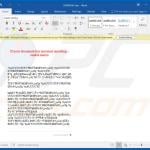
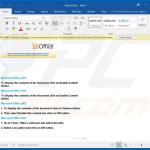
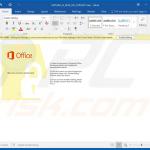
▼ Show Discussion